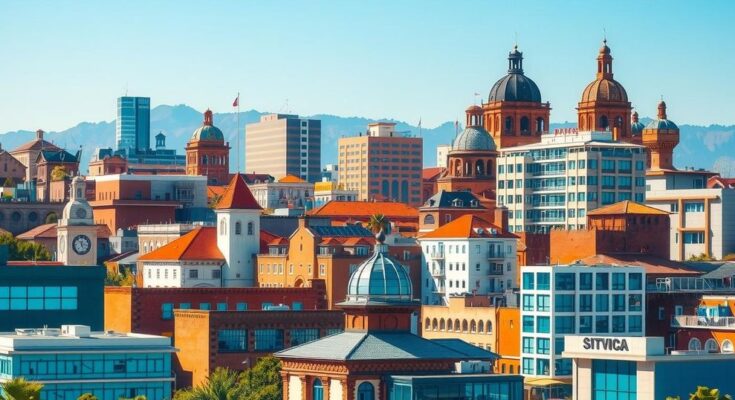South Africa’s 2025 budget presents a blend of tax increases, infrastructure investment, and debt management amid fiscal limitations and a sluggish economy. With a projected GDP growth of 1.8% and a 5% GDP budget deficit, the budget addresses employing workers’ concerns through VAT hikes and public sector salary agreements while also suggesting the need for private sector growth and skills investment for a better future.
South Africa’s 2025 budget, presented by Finance Minister Enoch Godongwana, seeks to navigate fiscal limitations, coalition complexities, and a sluggish economy. Projected GDP growth stands at 1.8% over the coming three years, alongside a consolidated budget deficit of 5% of GDP for the current fiscal year. The National Treasury has resorted to a combination of tax increases, infrastructure spending, and debt management to stabilize the situation. However, it remains critical to assess whether this budget adequately serves the workforce across public and private sectors and if it fosters a prosperous future for citizens.
The budget’s principal change includes a VAT rise from 15% to 16% by April 2026, aiming to raise R42.5bn over two years for crucial services like education and health. This increase, however, may diminish purchasing power for low- and middle-income individuals, especially as consumer price inflation is projected at 4.3% in 2025. Private-sector enterprises, particularly within retail and consumer goods, may experience lowered demand as households tighten their spending, potentially stalling wage increases or leading to layoffs. Countermeasures such as exempting additional food items from VAT and enhancing welfare grants could provide some relief, subject to effective implementation amidst bureaucratic delays.
Public sector employees are facing mixed outcomes as well. The budget allocates R23.4bn to honor a three-year pay agreement for the state’s 1.3 million workers. Nonetheless, there are concerns regarding the potential reduction of 30,000 jobs, indicating a leaner future for government workers. This contrast—salary increases for some while others face job cuts—captures the government’s precarious fiscal situation. For those retained, job security is encouraging; however, morale may be affected by the loss of colleagues. Furthermore, the promised R46.7bn increase in infrastructure spending may boost public-sector employment in related sectors, albeit procedural bottlenecks, such as inadequate rail systems, may hinder significant progress.
While the budget secures immediate gains through wage agreements and grant enhancements, it lacks innovative strategies to foster private-sector job growth or effectively protect citizens from rising costs. The anticipated primary surplus of 0.9% of GDP in the forthcoming fiscal year represents a fiscal achievement, yet it fails to alleviate the immediate economic challenges facing the workforce.
To foster a trajectory beyond the constraints imposed by this budget, three pivotal strategies must be initiated: First, enhancing private sector growth through tax incentives rather than relying exclusively on VAT increases. A 2022 World Bank report emphasizes the need for targeted corporate tax relief for small and medium enterprises (SMEs), crucial as this sector comprises 60% of the workforce. Secondly, investing in worker skills is essential to harness the full potential of a R1.03tn infrastructure investment; a dedicated R10bn vocational training fund could upskill labor for emerging sectors. Finally, reforming public-sector efficiencies through performance-based restructuring—rather than indiscriminate job cuts—would aid in retaining talent while improving bureaucratic processes.
For the average South African, such as Sipho, a factory worker, or Thandi, a nurse, the budget yields mixed results. Sipho appreciates the unchanged fuel levy, which keeps commuting costs manageable, but he is also aware that the VAT increase means purchasing fewer groceries. Thandi’s pay raise provides some relief, yet she is concerned about potential layoffs among her colleagues. Both benefit from the R35.2bn extension of the Covid-19 distress grant but remain skeptical about the projected 1.9% GDP growth in 2025.
In summary, while South Africa’s 2025 budget offers a cautious step towards fiscal sustainability—projecting debt at 76.2% of GDP and a narrowing deficit—it provides short-term comfort without the transformative vision needed for meaningful change. By refocusing on policies centering growth and skill investment, the National Treasury could embark on a path toward an improved future. Until measures are implemented that prioritize citizens, many remain sidelined, observing the arithmetic of finance while yearning for a plan that recognizes their circumstances.
The 2025 South African budget, while cautious in its approach, takes steps towards fiscal stability without offering substantial growth opportunities. The challenges faced by the private and public sectors indicate a need for more innovative strategies focused on job creation and economic resilience. The recommendations for optimizing tax policies, investing in skills, and improving public sector efficiency could present viable pathways to enhance overall economic conditions. Until such reforms are enacted, ordinary citizens like Sipho and Thandi may continue to feel the weight of economic constraints, eagerly awaiting meaningful progress.
Original Source: www.zawya.com




